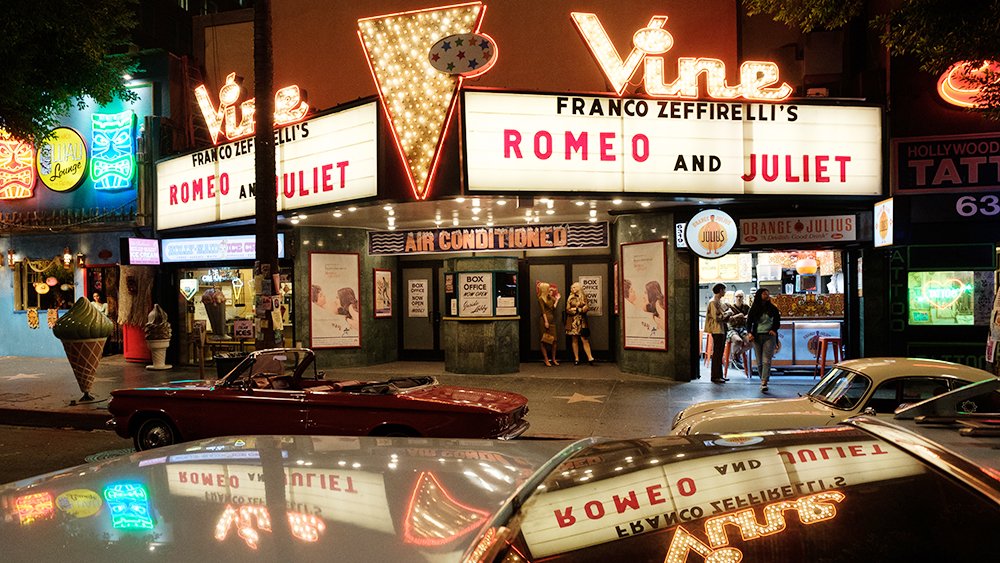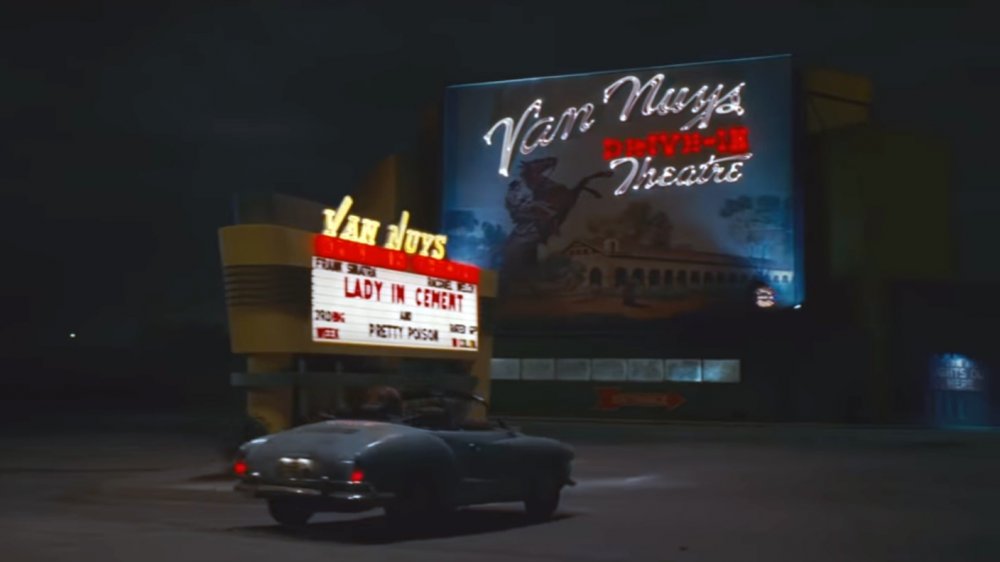Here's How Once Upon A Time In Hollywood Brought Back The 1960s - Exclusive
Once Upon a Time in Hollywood, the ninth feature film from director Quentin Tarantino, takes place in 1969 — when Woodstock rocked the world, Easy Rider and Butch Cassiday ruled the box office, and the Manson family terrorized Southern California.
You'll know as soon as you watch the movie, too. Other than the stellar performances by Leonardo DiCaprio and Brad Pitt as an actor and his stuntman, Once Upon a Time in Hollywood's biggest highlight is its stunning recreation of 1960s Hollywood. Every building, car, and extra looks like they've been plucked directly out of the past. It's a remarkable achievement, especially once you realize that the entire movie was made with almost no CGI.
As the film's second assistant director, Christopher T. Sadler, told Looper in a recent interview, Tarantino prefers to keep his shoots as real as possible. "If something's going to be heavy with visual effects, he would rather not shoot it," he said. "Everything we do, we try to do within the camera."
While Once Upon a Time in Hollywood does have a little bit of digital trickery — like the fantasy sequence in which DiCaprio's character, Rick Dalton, replaces Steve McQueen in The Great Escape – almost everything else is a practical or hand-made effect. That wasn't easy to do. Here's how Tarantino and his crew pulled it off.
Nothing better than the real thing
The centerpiece of Once Upon a Time in Hollywood's '60s revival are the sequences that take place on Hollywood Boulevard, one of the most iconic locations in all of Los Angeles. In the film, Hollywood looks exactly like it did in 1969, right down to the films listed on the marquee at the classic Vine Theater. That's not a set — it's the real Hollywood Boulevard, retrofitted to look like it did 50 years ago.
If you've ever been to Los Angeles, you know that Hollywood Boulevard is an extremely popular tourist location, the home to some of LA's most popular theaters and restaurants, and a major commuter road. Shutting it down for a film shoot, especially one so involved, is a massive undertaking. Thus, before Once Upon a Time in Hollywood could take over one of the LA's biggest streets, the production needed permission.
Sadler detailed, "We had an amazing location manager, a guy named Rick Schuler. He had to go and talk to the Hollywood City Council, and he sold them on what it would mean for the city, bringing classic Hollywood back around [...] At one point, [Schuler] got up and excused himself, walked out to what was essentially a broom closet and brought out Quentin to go and talk. He had Quentin hiding in there. Quentin came in and sealed the deal."
Once the permits were secure, production had to close the street down — a task that's easier said than done. "You can close it off to traffic all day, but you can't close it off to people all day," Sadler said.
So, how did the production keep gawking tourists from getting in the way of their shoot? By enlisting a whole lot of help.
"A lot of it is really just coming down with putting together an army and then taking it over," Sadler noted, further estimating that about 75 production assistants and 16 police officers helped corral onlookers and the shoot's many extras. A little kindness went a long way, too: "You just try to make friends with as many people as you can, try to be nice to people. You can't really tell them about the show, but you can make it into a nice experience, and then everybody's cool."
Going big by going small in Once Upon a Time in Hollywood
Of course, the Los Angeles area has changed a lot since the '60s, and not all of its most recognizable landmarks are still around. Take for example the Van Nuys Drive-In, behind which Brad Pitt's Cliff Booth parks his trailer. The classic drive-in theater closed up shop in 1992, ending a 48-year run, and was demolished in the late '90s. There's a school in its place now.
As such, it wasn't possible to film at the real location, so production had to begrudgingly use some visual effects. However, Tarantino opted to keep things old-school. Instead of rebuilding the Van Nuys Drive-In on a computer, visual effects maestro John Dykstra — you know, the guy who oversaw all the effects on the original Star Wars — built a miniature replica of the famous theater.
Even then, Tarantino refused to augment the set with CGI. He made Dykstra put toy cars in the itty-bitty parking lot, and fused some full-sized shots with the miniature in post-production. "We shot a parking lot with all of those cars moving around in it, put those real cars into the miniature, and then had Cliff drive through that," Sadler explained.
It sounds like a lot of extra work, but it all paid off. Once Upon a Time in Hollywood earned rave reviews and scored a number of awards nominations, including nods for Excellence in Production Design for a Period Film at the Art Director's Guild Awards and the Oscar for Best Production Design. It just looks that good.
Once Upon a Time in Hollywood is available on Blu-ray and digital now.


